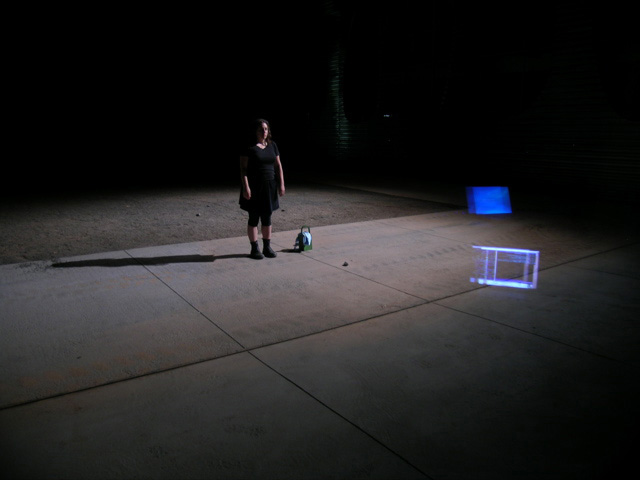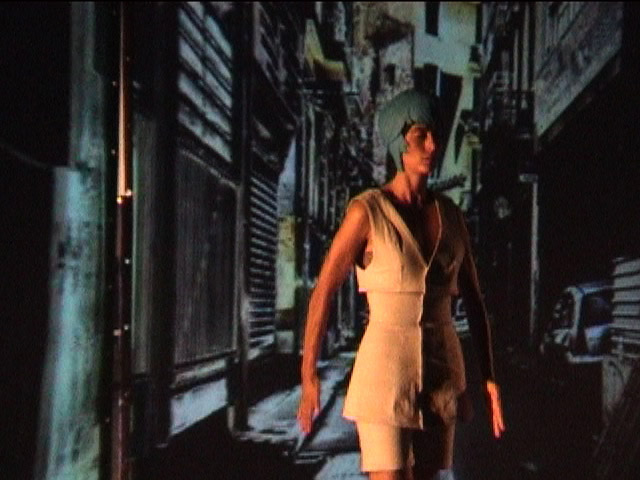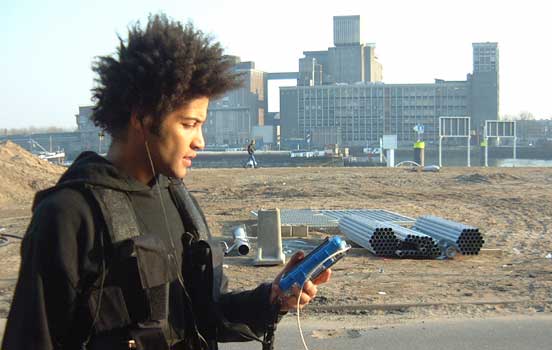
Part II
Throughout the workshop in Göttelborn, when the relationships between Player and Avatars, or between Player and game-system, were developed and rehearsed, we watched with great interest to see how the live contingencies – the chance events in Amsterdam or Sofia – would affect behavior and experience of the performers, and how the unpredictable live streaming media would enter into the prerecorded and edited documentary or animated film materials. Since not all of the team members of the I-Map project had first-hand experience of telematics and networked live art, the question of how the game environment was affected by the “alive” remained unanswerable until the webcam tests began, in the final week of the Göttelborn workshop, and again in the final days before the premiere of Walhalla at IME Industrial Performing Arts Complex in Athens.

Fig 4 Nancy Mauro-Flude and Ivailo Dimitrov enacting
webcam roles in test bed
simulation, outside Gray Gallery, Interaktionslabor Göttelborn © 2006
Interaktionslabor
At this late stage, the film aesthetic for the projections of the urban landscapes had already been developed by Ionna Tsinividi. All of her shoots and the editing were carried out with a particular projective staging in mind (the triptychon immersive environment, with a large flat screen of 12 meter (width) behind a 2m wide raiser stage platform, giving the Avatar a very compressed lateral space to act in and keeping her close to the screen space at all times in the performance.

Fig 5 Ermira Goro performing close to the screens. © 2006 Interaktionslabor
The script developed by Tzeni Argyriou and her teammates focussed first on the Avatar behavior, and only later shifted to the psychological experience of the Player, thus projecting the world of actions in the performance through the Player’s consciousness and allowing the audience to be in the place of the Player, experiencing his attention on the “physical layer” (interface) of the game, his obsession with the game as a way of avoiding the real world. The seductive avoidance is announced, quite poignantly, by a voice-over in the beginning of the performance, when the Player downloads the game:
Welcome to Walhalla: Walking is one of the easiest ways to be physically active. You can do it almost anywhere, and at any time […]
Let your fingers do the walking.
This means, in my understanding of games, that the interface is hyper-present as part of the Player experience, but as the audience cannot see Ivailo Dimitrov’s “physical” work (with joystick, button pressing, keyboard, mouse, etc), our attention instead is directed at the Avatar behavior – Ermira Goro’s performance of a non-human character who learns or adopts human behaviors.
Ermira’s interaction with the immersive game environment, no doubt, is one of the most fascinating aspects of the Walhalla performance. Throughout the workshops, however, it was also apparent that the preparations for the Avatar interactions were to a large degree controlled by technological research objectives that included not only the programming of the interactive software patches but developing a “sensor instrument” for Ermira, allowing her to control the image-movement, the game environment, herself. Multiple sensors, worn on the body and integrated into the costume, gave the dancer a physical handle on the filmic materials shot and edited by Ioanna Tsinividi. The compositional relationship between edited film clips, motion graphics and the live real-time sensor activation was not explored until the test bed workshop in Göttelborn, and the script at that point had become a time-cue story-board, full of technical signposts for video, audio, webcam, and actor “functions.” I call them functions as the script, in my opinion, was not fully developed until the very end, thus remaining a conceptual/technical storyboard for dramaturgical rehearsals, directed by Tzeni Argyriou and Zoe Chatziantoniou. An attempt to discuss the content and direction of the performance amongst the entire was made at the end of the first week at Göttelborn, especially as the webcam actors Ivailo Dimitrov and Nancy Mauro-Flude, and their team partners in Sofia and Amsterdam, needed to develop their roles and find the scope of their presence in the live work.
While the technical solutions to the software programming were addressed, and Ionna worked extra shifts to continue final editing of the innumerable film clips for the right, center, and left screens, the dramaturgical debate on content, the interrelations of the actor roles, and the choice for the game’s title remained quite inconclusive. The daily rehearsals thus followed technical scripts, but failed to address the underlying concerns that some of us voiced in regard to the constructive dissent offered by Nancy. Nancy asked us to ponder carefully the choice of the title “Walhalla” and the actions required of her in the streets of Amsterdam (the chosen location, Newmarket Square, borders on the red light district). Sher Doruff responded by invoking the political dimensions of the urban commodity spectacle constructed in our film-performance, asking whether our script writers were conscious of Guy Debord’s Marxist critique of spectacular captalism or Benjamin’s historical writings on the “flåneur” and the 19th century arcades. Christoforos Brellis sent us photos of Israeli school children “signing” Israeli missiles employed to bomb Beirut neighbourhoods at the very time we were rehearsing the performance, and my own notes show references to spectacle and heroism with regard to war, fake patriotism (Germany’s hyper-euphoria during the World Cup 2006), and fallen idols of our sports games (Tour de France doping scandals). I also insisted on asking questions about the kind of game we wanted to present to our audience:
A game is a rule-based formal system with a variable and quantifiable outcome, where different outcomes are assigned different values, the player exerts effort in order to influence the outcome, the player feels attached to the outcome, and the consequences of the activity are optional and negotiable. While the attraction of games may reside in their theme, the characters, and the aesthetics of the game environment, it has been often said that the immersive quality of gaming resides in the player activity. Is this what you want to externalize with the dancer/actor wearing the interactive sensors, thus “wearing the film”?
A computer game has to challenge, it must provide exciting situations to experience, stimulating puzzles to engage with, and interesting environments to explore. Gratification, game theorists argue, is not simply or effortlessly meted out. The pleasure of such play, furthermore, is derived from the refinement of performance through replay and practice. Consequently, it is essential that obstacles, irrespective of the form they take, must be real in that they must require non-trivial effort to conquer them.
What are the obstacles in the Walhalla scenario? The centrality of participation and the sense of “being there” also suggests that the player demands interaction in order to effectively feel he is enacting or role-playing the fantasy. What is the role playing fantasy, and why does our performance end with a “confession”? Is it the confession after a crime or the confession of a lonely man who has no life except the fetishied game experience? (Notes, 9.7.2006)
Doruff explained her intervention with a reference to the Situationists
and their
concepts of the psychogeography of the city, adding that
we should be aware that some spectators of this spectacle will make the analogy. I suspect any reviewer would, as the correlations are obvious. I'm wondering if the amorphy group is reinventing situationism without knowing anything about its history and without a clear political ontology? what was their input in the debord discussion?
I have a history and critique of the movement, "The Situationist
City" by Simon Sadler that augments Debord's texts rather nicely. It
focuses on the divisions (particularly with Constant) in the movement
pre SI. It also has some beautiful maps of a situationist Amsterdam
produced by Constant. I suppose if I do write something for the
catalog I will feel compelled to take this vector.
I decided yesterday that I could live with the superficial gloss of
the ads and even the lightweight "no logos" section as the spectacle
subsumes even its protests (echoed by Deleuze &Guattari, Hardt and Negri, Massumi, Agamben...). The aim seems to have shifted from an Ermira-Avatar that confronts a city to the more psychogeographic elements of the remote players so a gloss is all that could be achieved anyway. Though I'd like to avoid inventing my own fictive raison d'etre for
Walhalla and favor a consensus process, I can also see the conceptual
dissensus as something positive. Meaning is fractal. (email, 3.8.2006)
In conversations with Sher and Nancy about the translocal character of the webcam performance, it was suggested that Walhalla needed to acknowledge how it is levelling all differences between east and west and south, compositing a fictive urban landscape that is non-local, while using streaming media to construct an ecology, binding together different spatial realities. Such telematic performance, Sher argues, plays “with the tension between determinate structures and indeterminate potentials. Guy Debord and members of the Situationist International created the idea of the dérive as a contractual drifting through an urban landscape in expectation of a virtual appointment with someone you have never met – as a device to create conditions of possibility that were thoroughly tangible. With their neo-Marxist political affinities and disdain of commodifiable art practice, the Situationists nurtured the divide between the aesthetics and politics. In many ways, the convergences of psychogeographies were present in the process of making Cassis Caput (2003), an earlier work performed at Waag with webcam links to Berlin, London, New York and Pincher Creek. In Cassis Caput, the choice of public webcams as found objects/performance spaces, their accessibility as site-specific stages, was central to creating “conditions of possibility” from which events and relations may or may not occur. The dancers moved according to scored timelines from which improvised relations with observers, seen and unseen, emerged who functioned as “strange attractors”. The dérive model, the virtual appointment, was between a distant audience and remotely situated performers. The witnessing, the anticipation of fleeting unison gestures from different lands with different time zones captured moments of convergence. Tableaux were created through the frozen sequences of webcam images, the sense of being surveilled and the knowledge of a common task, enacted simultaneously in real and virtual landscapes, were present for all observer/performers. The local passers-by, unaware of an extended audience of players, amplified the element of random unpredictability and risk (http://interaktionslabor.de/lab06/webcam.htm).
Sher’s beautiful description of the aesthetics of such site-specfic work reverberated in my mind when I finally saw the potential of Walhalla emerge, namely in those moments during final rehearsals in Göttelborn when Ermira is caught in the urban environment, flooded by movement-images of people, shoppers, tourists, lovers, the young and the old, a hustle and bustle of crowds and floating advertisements, colors and graffiti, all the crazy signage and hieroglyphics of cities crashing past our Avatar, then suddenly we see the dark streetcorner in Amsterdam with Nancy, hesitating as if in a trance, holding out her arms, reaching for someone, an imaginary lover perhaps, a shadow in the mind, a broken memory, then sitting down on the pavement, head slumped forward.

Fig 6 Ermira Goro meets the abandoned avatar, Nancy Mauro-Flude, trapped in Newmarket Square, Amsterdam (on webcam). © 2006 Interaktionslabor
It is in such moments that Walhalla gains a deeper emotional resonance that takes us outside of the game system, tapping into a real that is not representable or programmable. On a technical level, we immediately note that the webcam streams were of “inferior” quality, and sometimes froze. We use the “refresh” mode with our own webcams in the Interaktionslabor, when we monitor our activities. The qualities of the still image update of webcams with two, five and sixty second intervals, deny viewers the dynamic, real-time flow of movement that a video camera would provide. Instead, rhythmic sequences of freeze frame images accentuate change by isolating moments (“samples”) and framing them. The absence of movement for the viewers and the absence of feedback for performers, weigh equally in the perceptual distribution of such inter-actions: Nancy is dis-connected from real contact with Ermira and Ivailo. Her real-life performance, with the full risk of being accosted and attacked by passers-by on the street-corner, is trustfully given to the camera transmitting the event to the “game” which the audience in Athens will have watched on September 13-14.
There are very few examples (like Cassis Caput ) in contemporary live art providing a critical context for See you in Walhalla, but we can mention three other works which involve performance/game structures, and also note the increasing interest among many digital artists and video/filmmakers (e.g. Beligian artist Anouk de Clercq) to investigate navigable game landscapes for their interactive work or, like Italian artist Damiano Colacito, exploit particular cult objects or tools in game landscapes by modelling and re-creating them as actual sculptural objects. Perversely, Colacito’s objects flee from the territories of virtual reality and materialise themselves in our world. Machinima, an underground digital movement connected to hacking and reverse engineering, puts game tools to unexpected ends by modifying content in the virtual environment. Usually, machinimas are produced using the tools (demo recording, camera angle, level editor, script editor, etc.) and resources (backgrounds, levels, characters, skins, etc.) available in a game. Ricard Gras, a producer at LA INTERACTIVA (Leicester), develops interactive content and machinima using game tools from EyeToy, SIMS and Second Life, exploring different engines and using machinima as a way to allow audience participation in the development of narratives. Others have called it a new form of independent filmmaking, treating the viewpoint the game gives them as a camera (“shooting film in a Virtual Reality”) and recording and editing that viewpoint into a new storydemos or narrative shorts (http://www.machinima.com/). In live art, the most notorious experiments with game structures to date have been devised by Blast Theory, a British group that developed some of their tools with the Mixed Reality Lab (Nottingham) and presented their city-wide interactive gaming at numerous festivals and venues around the world.

Fig 7: Can You See Me Now? © 2003 courtesy of Blast Theory
Day Of The Figurines (2006) and Uncle Roy All Around You (2003) followed their most well-know piece, Can You See Me Now (2001), in which a chase game is played online as well as on the streets. Players are dropped at random locations into a virtual map of a city. Tracked by satellites, Blast Theory's runners appear online next to the player. The runners use handheld computers showing the positions of online players to guide them in the chase. In this complex “mixed reality,” a player uses the arrow keys to flee down the virtual streets, send messages and exchange tactics with other online players: “An audio stream from Blast Theory's walkie talkies lets you eavesdrop on your pursuers: getting lost and out of breath on the real streets. If a runner gets within 5 metres of you, a sighting photo is taken and your game is over” (http://www.blasttheory.co.uk/). Blast Theory’s first major work, Desert Rain (2000), was a game and installation/performance placing participants in a collaborative virtual environment and sending them on a mission into a virtual world echoing with confused layers of mass media Gulf War images echoing Hollywood images. Influenced by Baudrillard's assertion that the Gulf War did not take place because it was in fact a virtual event, Desert Rain critically explored consumption of televisual information and the shifts in our perception and understanding of the world around us. Fascinatingly, the group thus attempted to explore the digital (real time processes, virtual realities) by asking how real events can attain the velocity of “real time” information, and when they become undistinguishable from the “information” which represents them.
Another artist drawn to a game-like scenario in her work is Hungarian-born perfomer Edit Kaldor, whose Or Press Escape (2003) presents her alone on stage in shadowy half-light in front of her computer's giant illuminated screen. With her back to the audience she types on her keyboard, as the screen displays her emotions and thoughts, her hesitations, as they happen in real/networked time. The screen reveals her solitary thoughts and confessions that suddenly become displaced by messages from outside. A poignant performance about the state of being physically alone, and without addressing the audience directly, Kaldor is the agile cursor on the computer screen: reacting in real time, in a virtual space. Strangely, of course, the set of codes associated with the daily use of computer communication is widely known by now, and thus can be theatrically reused in such a communal setting. The mode of performance even evokes the ritual character of the classical Greek amphitheatre and the functions of actors and chorus. The city, then and now, provides the setting for the tragedies, and we watch the masked character, accompanied by aulos and tympanon. The gods are invisible behind the networked cult practices.
A last example from contemporary digital art is the group Igloo (Ruth Gibson & Bruno Martelli) whose collaborative multimedia projects, such as Winterspace (2001-05), BackStrikesEmpire (2006), and Summerbranch (2006), investigate the function of the “real” in virtual environments, reflecting the interaction between people and landscape and illustrating the interpretation the human imagination places on the environment. The interactive installation Summerbranch is a computer-created virtual forest: the “user” (operating a joystick) or a computer character can blend into the “natural” environment captured and treated through the moving image. This work is a hybrid “machinima,” using the tools of the military-entertainment complex, computer gaming, motion capture, 3D environments and special effects to interrogate the artifice in our attempts to reproduce nature.
page 1 ..... page 2 ........page 3